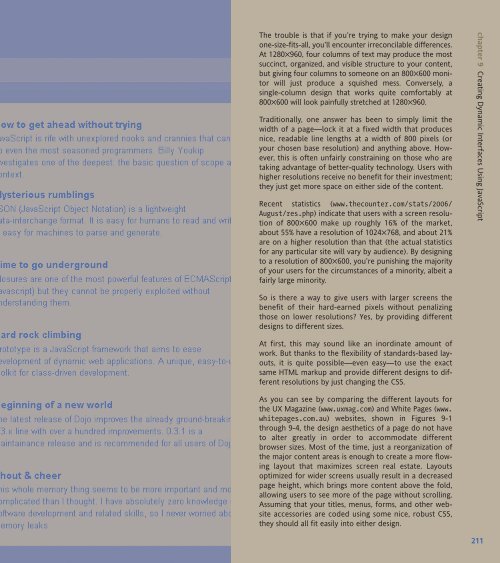WEB STANDARDS CREATIVITY
WEB STANDARDS CREATIVITY
WEB STANDARDS CREATIVITY
Create successful ePaper yourself
Turn your PDF publications into a flip-book with our unique Google optimized e-Paper software.
The trouble is that if you’re trying to make your design<br />
one-size-fits-all, you’ll encounter irreconcilable differences.<br />
At 1280✕960, four columns of text may produce the most<br />
succinct, organized, and visible structure to your content,<br />
but giving four columns to someone on an 800✕600 monitor<br />
will just produce a squished mess. Conversely, a<br />
single-column design that works quite comfortably at<br />
800✕600 will look painfully stretched at 1280✕960.<br />
Traditionally, one answer has been to simply limit the<br />
width of a page—lock it at a fixed width that produces<br />
nice, readable line lengths at a width of 800 pixels (or<br />
your chosen base resolution) and anything above. However,<br />
this is often unfairly constraining on those who are<br />
taking advantage of better-quality technology. Users with<br />
higher resolutions receive no benefit for their investment;<br />
they just get more space on either side of the content.<br />
Recent statistics (www.thecounter.com/stats/2006/<br />
August/res.php) indicate that users with a screen resolution<br />
of 800✕600 make up roughly 16% of the market,<br />
about 55% have a resolution of 1024✕768, and about 21%<br />
are on a higher resolution than that (the actual statistics<br />
for any particular site will vary by audience). By designing<br />
to a resolution of 800✕600, you’re punishing the majority<br />
of your users for the circumstances of a minority, albeit a<br />
fairly large minority.<br />
So is there a way to give users with larger screens the<br />
benefit of their hard-earned pixels without penalizing<br />
those on lower resolutions? Yes, by providing different<br />
designs to different sizes.<br />
At first, this may sound like an inordinate amount of<br />
work. But thanks to the flexibility of standards-based layouts,<br />
it is quite possible—even easy—to use the exact<br />
same HTML markup and provide different designs to different<br />
resolutions by just changing the CSS.<br />
As you can see by comparing the different layouts for<br />
the UX Magazine (www.uxmag.com) and White Pages (www.<br />
whitepages.com.au) websites, shown in Figures 9-1<br />
through 9-4, the design aesthetics of a page do not have<br />
to alter greatly in order to accommodate different<br />
browser sizes. Most of the time, just a reorganization of<br />
the major content areas is enough to create a more flowing<br />
layout that maximizes screen real estate. Layouts<br />
optimized for wider screens usually result in a decreased<br />
page height, which brings more content above the fold,<br />
allowing users to see more of the page without scrolling.<br />
Assuming that your titles, menus, forms, and other website<br />
accessories are coded using some nice, robust CSS,<br />
they should all fit easily into either design.<br />
chapter 9 Creating Dynamic Interfaces Using JavaScript<br />
211















